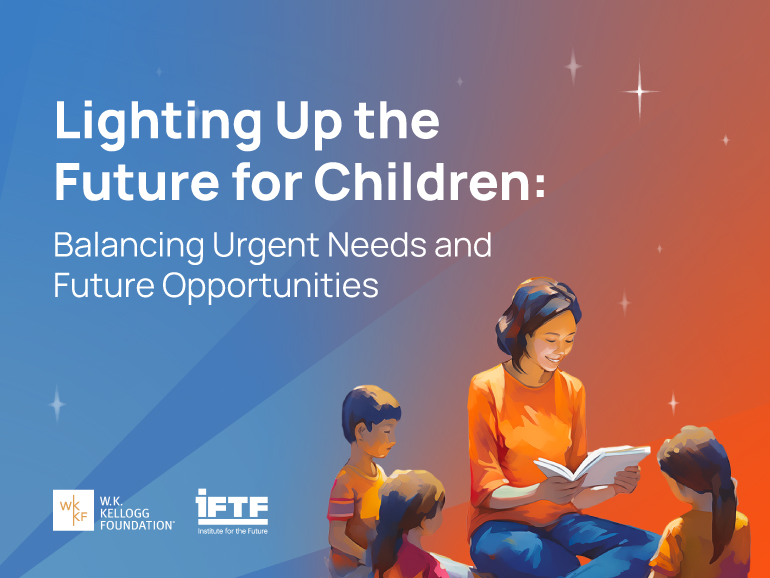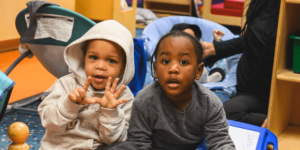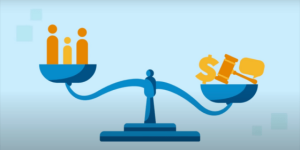A New Strategic Foresight Map & Guide
to Spark a Future Where All Children Thrive
In a world filled with unprecedented challenges and opportunities, a new strategic tool offers a roadmap to guide policymakers, communities, leaders, nonprofits, funders and movement leaders toward achieving the ambitious goal of creating a world where every child and family can live with the highest standards of human dignity.

This strategic foresight map, “Lighting Up the Future for Children: Balancing Urgent Needs and Future Opportunities,” was produced by the Institute for the Future (IFTF) in partnership with the W.K. Kellogg Foundation (WKKF) and is now available as a strategic resource to align stakeholders within the child-centered ecosystem and connect present-day work with a future-ready vision of thriving children and families.
“This foresight map is not merely a speculative exercise, but a guide based on the signals we are seeing today combined with participatory foresight research and methods to help support more informed choices,” said Marina Gorbis, executive director, Institute for the Future. “It is intentionally designed not only to spark conversations, but to catalyze strategic planning and interventions aimed at improving the lives of children in the future.”
Unlike traditional planning approaches that primarily focus on addressing immediate issues, this foresight map goes further by identifying external trends, forces, risks, and opportunities that we are likely to face on the path to a more child-centered future. The map features ten forecasts for the year 2035, describing potential outcomes based on various strategic choices and actions that stakeholders may take over the next decade, within the broader context of social, natural and technological changes that are already influencing our present conditions. By projecting the potential impacts of short- and long-term actions over a ten-year horizon, the map encourages changemakers in the child-centered ecosystem to consider the broader implications of their decisions on communities, taking into account community agency and power, and the rate at which conditions for children, families, and communities may change.
IFTF led the research process, which was informed through more than a year of customized sessions designed using foresight practices for WKKF staff, grantees and partners, as well as listening and learning from experts and families in communities. In all, more than 2000 people from the United States, Haiti and Mexico contributed their insights to this research process.
“One of the core values of the Kellogg Foundation is embracing community-led visions and approaches,” said Carla Thompson Payton, WKKF’s chief strategist and impact officer. “Through this partnership with IFTF, we spent a year enhancing our ability to listen to our communities and lean into their deeply-held visions for the future, and fostering foresight and futures thinking among our staff, grantees, and external partners to better prepare us to address the challenges and opportunities of the next decade together.”
Stakeholders are encouraged to engage with the foresight map, consider the reflection questions in interactive processes, and join the conversation about the future of children, families and communities. The brief two-page guide offers questions and ideas for how to collaborate using the strategic foresight map.
“‘Lighting Up The Future For Children’ opens the door to exploring and better understanding the external forces already impacting children, families and communities. It can spark community-led conversations and strengthen the connection between our present-day actionsand our long-term visions,” said Alandra Washington, WKKF’s chief transformation and effectiveness officer. “We hope this tool inspires funders and nonprofits to take the long view, to make decisions beyond a current grant cycle, and to reimagine what we want for our children’s future.”
“This map and interactive process provides pathways for anyone focused on child-centered work to develop a measured and coherent approach to deploying long-term strategies and near-term actions needed to create a future where children can thrive, said Gorbis. “Let it inspire, challenge, and guide us as we light up the future for children.”
The full report and companion guide are available in English, Spanish and Haitian Creole. For more information, visit the IFTF and WKKF websites.
Follow IFTF at linkedin.com/company/institute-for-the-future and WKKF on Linkedin.com/company/KelloggFoundation and use the hashtags #LightUpTheFuture #EveryChildThrives #FutureReadyPhilanthropy to join the conversation.
About IFTF
Institute for the Future (IFTF) is the world’s leading futures organization. For over 55 years, businesses, governments, and social impact organizations have depended upon IFTF global forecasts, custom research, foresight education, and training to navigate complex change and develop future-ready strategies. IFTF methodologies and tool sets yield views of transformative possibilities across all sectors that together support a more equitable and sustainable future. IFTF is a registered 501(c)(3) nonprofit organization based in Palo Alto, California. www.iftf.org
About W.K. Kellogg Foundation
The W.K. Kellogg Foundation (WKKF), founded in 1930 as an independent, private foundation by breakfast cereal innovator and entrepreneur Will Keith Kellogg, is among the largest philanthropic foundations in the United States. Guided by the belief that all children should have an equal opportunity to thrive, WKKF works with communities to create conditions for vulnerable children so they can realize their full potential in school, work, and life.
The Kellogg Foundation is based in Battle Creek, Michigan, and works throughout the United States and internationally, as well as with sovereign tribes. Special attention is paid to priority places where there are high concentrations of poverty and where children face significant barriers to success. WKKF priority places in the U.S. are in Michigan, Mississippi, New Mexico, and New Orleans; and internationally, are in Mexico and Haiti.



